American food gets an unfair rap these days. With the rise of ethnic cuisines – whatever that means, in this great melting pot — and supermarkets full of salad bars and microwave dinners, it’s easy to forget how many extraordinary homegrown delights are still served on tables across the land. Foods with a sense of place. Foods, I don’t feel too bold saying, that helped make America great.
It’s time to celebrate a few.
Our list isn't meant to be comprehensive. We didn't include barbecue because once we started our accounting — from North Carolina pork to Texas Hill Country brisket — it became clear we’d need a long, separate list to give BBQ its due. And apple pie, while iconic, is a European import that spread everywhere in Johnny Appleseed's wake.
All these 10 express their origin, though. And each is worth a trip to hunt in its native habitat, from sea to succulent sea.
1) New England clam chowder (Massachusetts)
While no trip to Boston is complete without a proper bowl of clam chowder, it's not fair to hand this one to Massachusetts alone — or to pretend that chowder is any one thing.
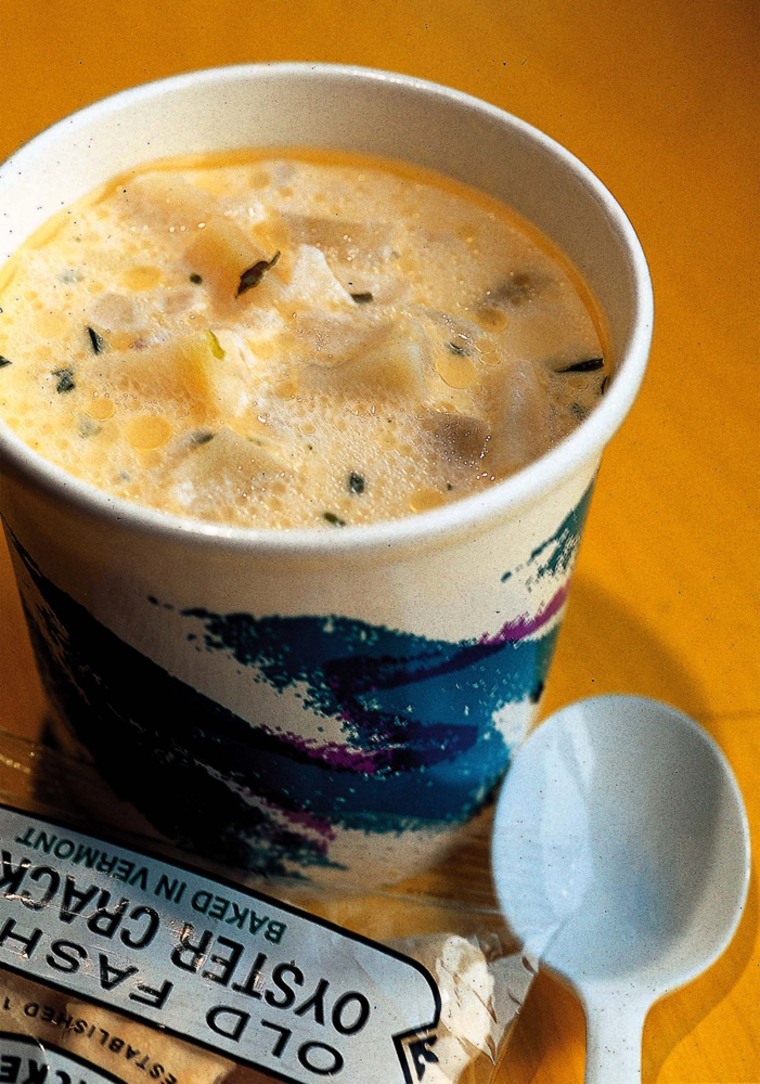
Cod or bass were added in by the end of the 18th century, but not until the mid-1800s do clams begin to appear in recipes, and the milk — now considered an essential component — didn't appear until the 1860s or so.
The formula was cast by the early 20th century, though the creamy classic occasionally vied for competition with tomato-based Manhattan clam chowder. (Not, in fact, from Manhattan.)
The clam of choice is usually the Eastern variety known as a quahog (CO-hog), with a shell thicker than three inches; its meaty insides help give chowder a briny kick. Smaller clams of the same type, Mercenaria mercenaria, are better known as littlenecks or cherrystones and not usually used for chowder.
A proper chowder is deep and aromatic, with layered flavors atop a porky foundation. Between the Red Sox finally winning, and all that chowder, I'd warn residents of Boston to expect a flood of visitors who won't leave. And I'm not talking about Harvard students.
2) Pastrami (New York)
Reasonable citizens can disagree about which pastrami is the best in New York, and therefore the universe. Some praise the prototype at the ever-flashy Carnegie Deli. Others stake their money on the thick, hand-cut version at Katz’s. (While we appreciate the fervent West Coast partisanship of Langer’s fans in L.A. ... c'mon.)
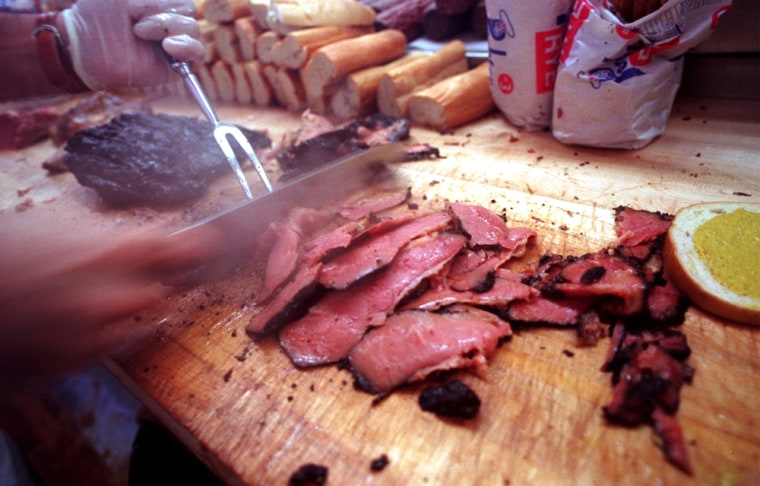
What’s beyond dispute is that pastrami on rye is the Platonic ideal of deli food: two simple slices of good caraway-laced bread, an inconceivably high pile of warm sliced beef, perhaps a modest smear of mustard.
Pastrami is the very triumph of man over meat. It begins with a simple slab of brisket (or plate) — a cut that, unlike the simple grill-and-serve of more obvious hunks of cow, begs for transformation.
Then a dry cure: salt, undoubtedly a good portion of cracked black pepper, maybe some sugar and spice — which sits on the meat as it is smoked with eternal patience. New York meat expert Mr. Cutlets notes the Carnegie cures their pastrami for two weeks. When finally ready, whole pastramis are steamed for several hours before serving.
It’s an Old World cooking schedule, with a name derived from a Yiddish take on Romanian pastrama, and even older possible roots in Turkey. But it was New York’s Jewish immigrants who claimed pastrami as their own in the early 20th century, and made it a staple of culinary life in this greatest of food cities.
pagebreakShoofly pietrue
3) Shoofly pie (Pennsylvania)
Americans are suckers for fruit pies, but this Pennsylvania Dutch treat strips pie-making to its essential, tasty core. Crust, with molasses and crumbs. Nothing more. (Though James Beard insisted raisins were part of the mix.)
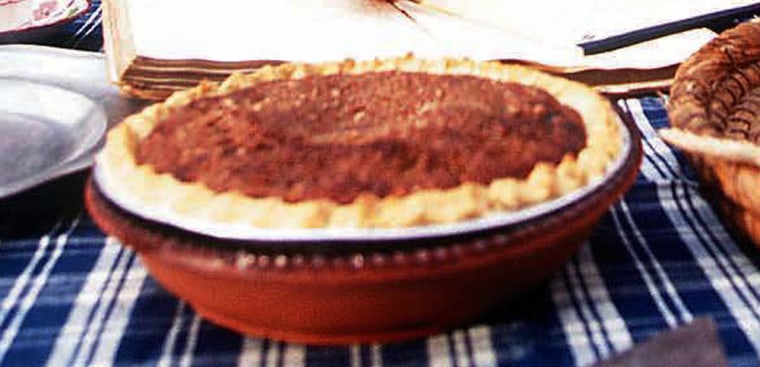
Its origins are slightly gooey. Author John Mariani found a first reference in 1926, while Linda Stradley posits that it’s an update of treacle tart, which was made with refined cane syrup.
In either case, the Amish — who enjoy both “wet” (crumbs on top) and “dry” (crumbs mixed in) versions — have claimed it as their own. Some might claim the dry is really more a crusted cake than a pie. We're not going to quibble, because either way, it tastes pretty good.
Those crumbs add texture to a dense, rustic molasses taste. In Amish country, you might be told the name refers to the constant need to shoo flies away from these toothachingly sweet treats and the pools of molasses that formed atop them.
Variations abound, incorporating chocolate or Steen's cane syrup. They're good too, though the original doesn't need much updating, save for a dollop of whipped cream on top.
Shoofly pie is perfect baked-good simplicity. It’s proof that sometimes basic ingredients are all you need.
4) Smithfield ham (Virginia)
Italians have their prosciutto, Spaniards their serrano. These are hams of character and substance, hams with history. So why are so many American hams just pasty hunks of flavorlessness?
Many Southerners never succumbed to such folly, and thank goodness. While you can find a proper country ham in smokehouses across the South, Virginia has a true ham legacy, housed in the small city of Smithfield, just across the James River from Newport News.
Smithfield's ham history traces back at least to 1779. A 1926 state law permits only a ham cured within the town limits to be awarded the name.
Over the decades, the town’s many smokehouses — Gwaltney, Luter’s, and so on — have been filtered into a single company, Smithfield Foods, which is to hogs what General Motors is to cars. As the only remaining game in Smithfield town, it holds claim to what’s arguably the closest American equivalent of Europe's protected food appellations.
Gone are the days of local pigs foraging in nearby peanut fields, even though it was long claimed the nuts provided the hams with a distinctive earthy note. Though modernity has made the dry-curing process more uniform, nothing can speed the six months needed to shrink these hams down to size and focus their flavors to salty perfection.
The flavors evoke a time when pigs aspired to something more noble than being the other white meat. In his own ham paean, the New York Times’ R.W. Apple noted that Smithfield ham “bears about as much resemblance to your pink, watery, run-of-the-mill brine-cured ham as a horse chestnut does to a chestnut horse.”
So if you find a Italian or Spaniard on a ham rant, serve them up a slice of Smithfield on a biscuit, or fry some up with red-eye gravy. It’s time to take pride in Americans' own little slice of hog heaven.
5) Po-boys (Louisiana)
In most American sandwiches, the more ingredients, the merrier. The French, by contrast, choose a few essential items, and a similar spirit seems to inspire the New Orleans po-boy. You certainly can find po-boys that are piled high inside, but some of the best are models of extraordinary restraint.
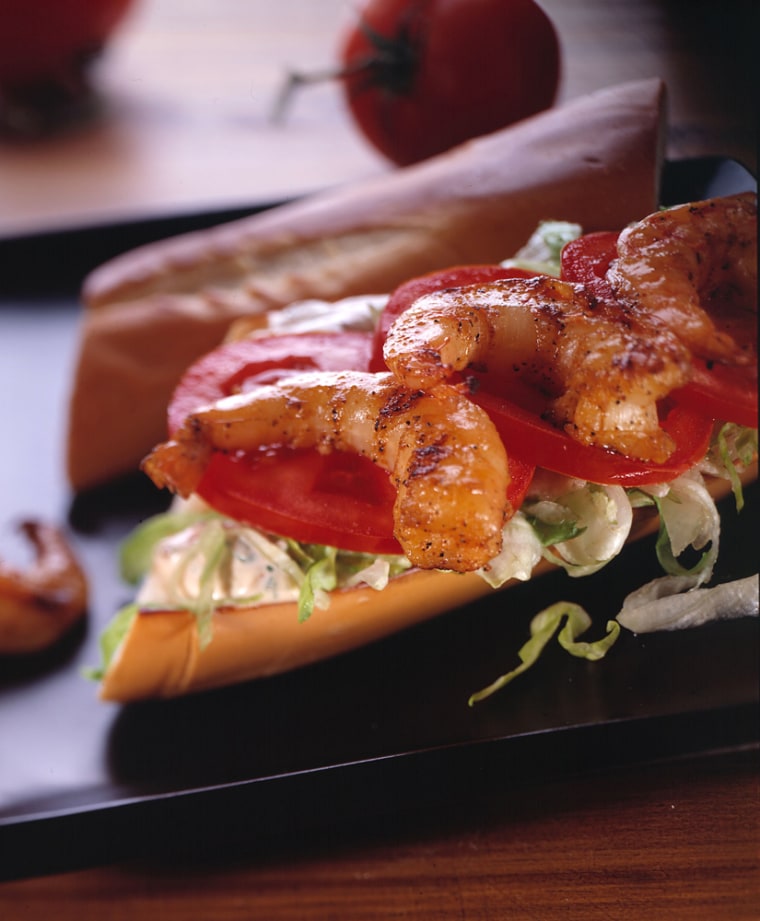
Food writer Pableaux Johnson calls New Orleans “a city powered by the po-boy,” and the Crescent City abounds with po-boys of every filling imaginable. Hot sausage? Of course. Soft-shell crab? No prob.
Whether it’s the fried oyster po-boy at Liuzza’s by the Track or one of the many unnamed concoctions at Guy’s, you’ll never run out of choices.
A few things remain constant: You want it dressed (lettuce and tomato), you want the bread same-day fresh and you want it served up with a minimum of fuss.
After all, this is workaday food, meant for hungry people of modest means. It’s often attributed to two brothers, Benjamin and Clovis Martin, who ran a restaurant in the city’s French Market. One apocryphal story has the Clovises serving up free sandwiches during a 1929 transit strike for those “po’ boys” on the picket line. Complicating that portrait, author John Mariani notes “poor boy” was a synonym for sandwich as early as 1875.
New Orleans is a city in constant struggle with modernity. Worried by the onslaught of Subway and Quiznos, members of the newly hatched New Orleans Po-Boy Preservation Society are fighting to ensure we don't forget their city’s loaved legacy.
If you’ve ever eaten a proper po-boy, you know it's simply unforgettable.
pagebreakFajitastrue
6) Fajitas (Texas)
Food, in the cowboy tradition, is usually more pragmatic than transcendent. Fajitas are a notable exception.
Unless you happen to live in Texas — and possibly even then — forget everything you know about the fajitas in your local sorta-Mex restaurant. Shrimp or veggie fajitas? Pretenders to the throne.
In 1984, Texas A&M lecturer Homero Recio traced fajita history back to the ranches of 1930s south and west Texas. He also surmised that his grandfather, an butcher in Premont, Texas, helped coin the term.
“We talked to my grandmother, who was from northern Mexico, and she said she had never heard the name in Mexico,” Recio recalls, “But she had heard it from her husband, who was in south Texas.”
According to Recio, the Mexican cowboys known as vaqueros often received throwaway scraps as part of their pay, including the cow’s diaphragm, which helps hold in the animal’s innards. In Spanish, faja means belt or sash; fajita would be “little belt.”
The diaphragm, which we now call a skirt steak, is covered with a tough membrane that allowed the vaqueros to grill it outdoors directly on open mesquite coals — the prototypical fajita.
Fast forward to the late ‘60s, when Sonny “Fajita King” Falcon started selling fajitas in Kyle, 20 miles south of Austin. Falcon spread skirt-steak gospel at fairs throughout the state, finally opening a Fajita King stand in Austin in 1978. The dish sprang to nationwide success after a restaurant at the Austin Hyatt Regency put it on the menu in 1982.
Fame can corrupt a food, and absolute fame dealt fajitas a double blow. First, the price of skirt steaks — formerly one of the best deals at the meat counter — has skyrocketed. Second, the term “fajita” has come to represent nearly any grilled tidbit, marinated and served up sizzling hot with tortillas.
If you want a true fajita, fear not. Beginning last fall, Austin newspapers reported that Falcon, who left the food industry in the early 1980s, was staging a comeback in Kyle, where he started his fajita legacy in 1969.
So forget the canned mariachi music, strawberry margaritas and fajitas you think you know. A true American delicacy awaits, just north of the border.
7) Chicago hot dogs (Illinois)
Even Windy City residents would have to admit the American tradition of this noble sausage began in New York, though St. Louis makes a strong bid as well. The first big Chicago connection to the frankfurter came during the 1893 Columbian Exposition, when vendors hawked endless quantities of sausages from their carts.
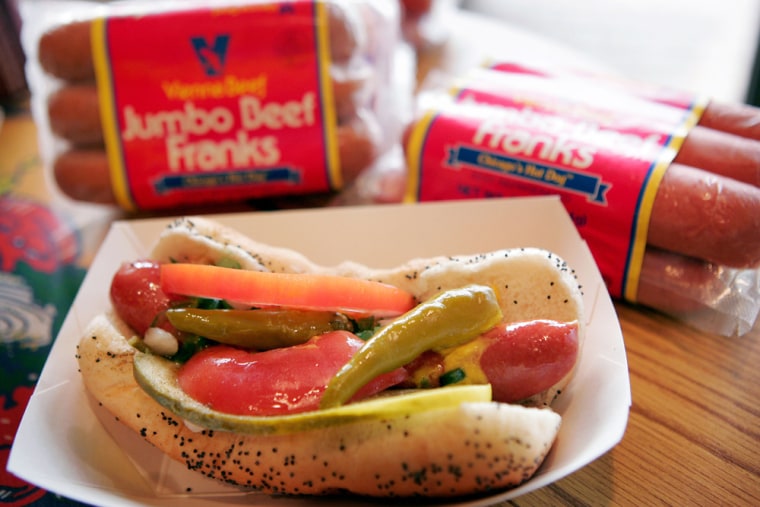
Though outpaced by New York and L.A., Chicagoans pack away their share of franks, over 20 million a year. And Chicago is a city where less is not, in fact, more — hence the perfect venue to take the wiener’s simple Coney Island styling and go nuts.
A proper Chicago dog needs be dragged through the garden, as you might tell your vendor: You take a Vienna Beef sausage, nestle it in a poppy-seed bun, then add mustard, relish, chopped onion, tomato, pickled peppers, a dash of celery salt and perhaps a pickle spear or two. Hold the ketchup. A hearty handheld meal.
As with any perfect food, exact ratios and sources and preparations are up for debate. And yes, we know New Yorkers allege that Chicago’s red hots are overladen, while the Second City loves to mock the Big Apple’s weenies as wimpy and wan.
We’ll save that endless battle (for pizza) and simply acknowledge that Chicago’s chock-full approach is a perfect summer reminder that sometimes there’s no place better to eat than the street. Except maybe at the ballpark.
8) Chile verde (New Mexico)
State flag? Sure. State bird? You bet. And since 1996, New Mexico has prided itself on having an officially proclaimed state question: “Red or green?”
The reference, of course, is to chile sauce or stew. And while we don’t mean to take sides (I guess we’d order “Christmas,” a little of both) there’s something about New Mexican chile verde that not even chili-loving Texas can trump.
Chile peppers themselves (New Mexico’s state vegetable, needless to say) have grown there at least since explorer Don Juan de Oñate brought them in 1598 on his trek to extend the Camino Real.
Oñate was ultimately banned from New Mexico for abuses of power, but the pungent pods remained.
Whether you choose red or green, it’s from the same fruit — usually a robust form of the New Mexico chile like the popular "6-4," not the milder version formerly called Anaheim. Green chile is made from fresh pods, while red is made from riper, dried pods. Recipes vary, but garlic and onion are usually key, and perhaps meat if you're making a stew.
Fresh from the plant, green chile can be deceptively hotter than red. And with harvest due in about a month, it’ll soon be prime time for a bowl or two in New Mexico, where they understand that chile verde is so good, it should go atop nearly everything. Though we wouldn't say no to red.
9) San Francisco sourdough (California)
The use of a sour starter for bread predates not only San Francisco but most of European history. Yet its American genesis came during the 1849 California gold rush, when baker Isidore Boudin baked French bread in San Francisco and sold it to miners headed for the hills of what had not quite yet come to be known as the Golden State.

Rather than pack yeast into the wilderness, prospectors could take a bit of starter along with them and keep reusing it to bake their own bread. John Mariani writes that “it was because of the bread’s popularity among miners that ‘sourdough’ became a slang term for the prospectors themselves and, later, by extension, all Alaskans,” since the city by the bay was also a jump-off for the later Yukon gold rush.
The tang of a proper San Francisco sourdough is unmistakable, as is the thick crust and irregularly holed interior. Similar breads can be replicated anywhere, of course, but residents often claim the Bay Area possesses a climate unique to help the necessary starter bacteria flourish. (Indeed, some microbiologists finger a helpful culprit called Lactobacillus sanfrancisco.)
Astoundingly, the Boudin bakery still survives to this day — claiming to use a portion of the original “mother” starter that began it all. But other contenders abound, like Berkeley-based Acme Bread. L.A.'s La Brea Bakery even caused a stir when, in 1997, the editors of the San Francisco Chronicle picked its parbaked sourdough baguette over local offerings.
No matter. San Francisco has indelibly set the sourdough bar. Sit at the waterside Ferry Plaza, take an unadorned bite of the city’s original culinary trademark, and wonder why Americans ever settle for plain old white bread.
10) Olympia oysters (Washington)
Sometimes a food comes back from the brink. The Olympia oyster offers one of those happy stories.
At least it might.
Once abundant in Northwest waters, this little bivalve (Ostrea lurida) was sought out by native tribes and settlers alike. Native from southern Alaska to Baja California, they thrived in the shallow tidelands of the Washington coast. Timber ships in the mid-1800s regularly carried them south to San Francisco, ushering in the Northwest’s reputation as a shellfish haven; still more were shipped to Seattle.
Production soared by the 1890s, then fell off in the early 20th century as waste from pulp mills and other pollution dwindled oyster stocks. As harvest of the Olympia dropped by 90 percent, oyster farmers imported non-native species like Pacific and virginica (Eastern) oysters to replace them. Those larger oysters crowded out their smaller cousins, and predators like the Japanese oyster drill, a snail, did further damage.
In 1998, Washington began a dedicated program to reseed wild oyster beds with the Olympia. At the same time, commercial farmers in southern Puget Sound carefully began to raise and harvest the Olympia for commercial sale in their own beds — resulting in a curious twist: Eating the Olympia can actually help fund its return.
It’s not quite a success yet. Olympias are still being harvested in miniscule numbers, though a similar restoration is under way in San Francisco Bay and aquatic conservationists like the Blue Ocean Institute are optimistic.
The oyster itself is a diminutive gem, from the size of a quarter to a half-dollar, subtle and slightly sweet when eaten raw, with an occasional metallic bite at the end. It’s a less filling, more delicate experience than slurping down a meaty virginica or Kumamoto. But for shellfish lovers, it’s an experience not to be missed — one that nearly vanished forever into the muddy annals of American cuisine.